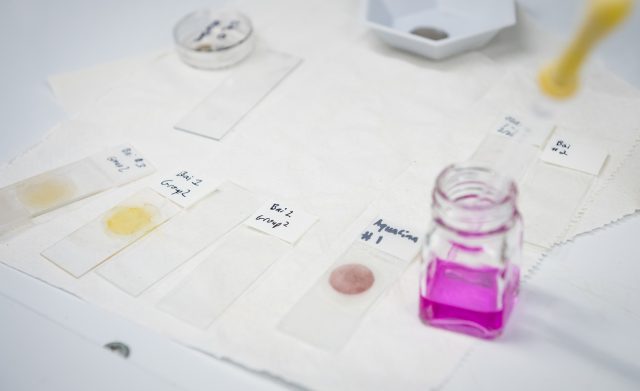
UM is acquiring an advanced Fourier transform infrared imaging microscope through a National Science Foundation grant. Expected to arrive in the fall, the instrument will be useful to researchers in fields such as forensics, pharmacy, biomolecular sciences, engineering, anthropology and chemistry – where it can be used to further study microplastics in the environment. Photo by Megan Wolfe/Ole Miss Digital Imaging Services
OXFORD, Miss. – A powerful new imaging instrument arriving soon on the University of Mississippi campus promises to open novel worlds of research exploration.
Through a National Science Foundation grant, the university is acquiring an advanced Fourier transform infrared, or FTIR, imaging microscope, a device that can chemically analyze, identify and measure tiny samples, such as particles, fibers and forensic traces.
The analytical tool provides useful information on molecular structure, surface characteristics and the distribution of chemicals in samples, and has uses in fields such as chemistry, forensics, pharmacy, biomolecular sciences, engineering, anthropology and more.
“It’s exciting to consider all the research that this new advanced instrument will enable and for the students that will receive training on it,” said James Cizdziel, professor of chemistry and biochemistry and UM coordinator of forensic chemistry. “I’m honored that the NSF recognizes that the work we do here is important and grateful to my co-principal investigators, my department and the university for supporting this effort.”
Cizdziel served as the principal investigator on the grant. Co-principal investigators include Matteo D’Alessio, assistant professor of civil engineering; Carolyn Freiwald, associate professor of anthropology; Vijayasankar Raman, a senior research scientist at the National Center for Natural Products Research; and Courtney Roper, assistant professor of environmental toxicology and research assistant professor in the Research Institute of Pharmaceutical Sciences.
Part of Cizdziel’s research focuses on understanding the occurrence, sources and fate of microplastics in the environment.
“The microscope will help us identify the type of plastic in tiny particles of plastic pollution,” he said. “Another part of my research is engaged in forensic research.

James Cizdziel, professor of chemistry and biochemistry, is principal investigator on a National Science Foundation grant that will allow UM to acquire an advanced Fourier transform infrared imaging microscope. Photo by Megan Wolfe/Ole Miss Digital Imaging Services
“Together with Dr. Murrell Godfrey (an associate professor of chemistry), we will use the microscope to develop methods to detect gunshot residue particles on forensic samples and to map illicit drugs and their metabolites in latent fingerprints.”
Demonstrating its interdisciplinary nature, the instrument also will be used by faculty exploring a range of fields, from investigating the chemical profiles of fine airborne particulate matter, which could lead to a better understanding of the sources of air pollution, to providing a molecular-level understanding of the properties of new materials for low-cost water treatment.
“Faculty from five different departments on campus will integrate the microscope in their undergraduate and graduate courses,” Cizdziel said. “By exciting and training students in the emerging technique of chemical imaging, we will better prepare students for graduate school or a career in industry.
“Moreover, the instrument will be used by dozens of students in faculty-mentored research projects.”
Freiwald’s research interests include migration and diet, which she studies using the bone chemistry of ancient teeth and bones recovered from archaeological sites in Belize, Guatemala and Mexico. As part of her lab’s bioarchaeology research, she will work with students to assess the integrity of the materials using the microscope before selecting the scientific samples, saving money and producing better, more reliable results.
The FTIR also will be used to identify the animals used to make bone tools, which are difficult to identify using traditional methods. Deer were common raw materials, but ancient peoples also used bones from sea mammals, jaguars and sometimes even humans.
“I can’t wait to get into the lab with my students and see what they discover,” Freiwald said. “They will have new and interesting ideas that I have not even thought of yet.”
Expected to be delivered and installed this fall, the FTIR imaging microscope will be housed in the Department of Chemistry and Biochemistry in the Forensic Microscopy Laboratory. The instrument also will be available to researchers from outside Ole Miss.
The grant allowing for the purchase of the microscope is made possible through the NSF Division of Chemistry, which supports a vibrant research community engaged in fundamental discovery, invention and innovation in the chemical sciences, including projects exploring the frontiers of the discipline and developing the foundations for future technologies and industries.
The grant is No. 2116597 and is titled “MRI: Acquisition of an Advanced FTIR Imaging Microscope for Multidisciplinary Research and Training in the State of Mississippi.”